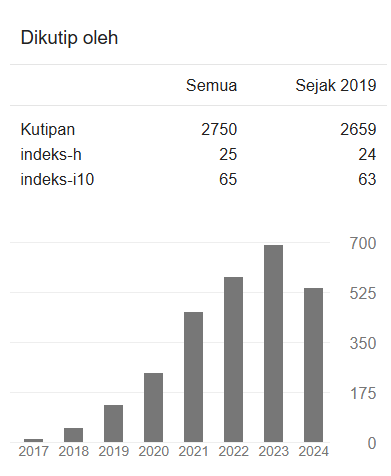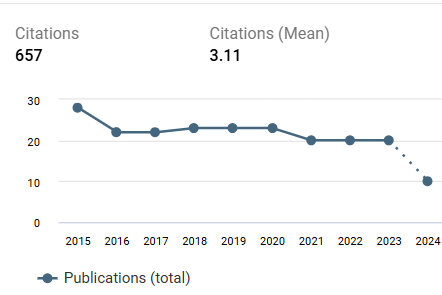Development of an integrated statistics pocket book on culture and Islamic value
DOI:
https://doi.org/10.22219/jinop.v10i2.33278Keywords:
Integration, Islamic Culture, Istiqra’, Statistics Pocket Book, ValuesAbstract
This research discusses the development of a statistical pocketbook integrated with Islamic values and culture to enhance students' understanding and appreciation of statistics within a cultural and religious context. This research aims to develop a statistical pocket book that meets valid criteria. This research uses the Research and Development (R&D) method. The development model used is ADDIE which consists of 5 development stages, namely: (1) analysis stage, (2) design stage, (3) development stage, (4) implementation stage, (5) evaluation stage. However, this development research only uses four stages, namely (1) analysis, (2) design, (3) development and evaluation. This research was conducted at FTIK IAIN Manado. Data collection was carried out using questionnaires and tests. Instruments were a marketing/content expert validation sheet and a media/design expert questionnaire validation sheet. Based on the results of the questionnaire analysis, the results obtained were that the statistics pocket book integrated with Islamic values and culture met the valid criteria for use in statistics learning, seen from the assessment results for validation by content/material experts (85%) with very valid categories and media/design experts (91 %) is also in the very valid category, the average percentage of the practicality test is 91% in the very practical category. So, the Statistics pocketbook that has been developed is valid and practical for use in learning because it is integrated with Islamic values and culture.
Downloads
References
Abdusysyakir. (2014). Model Integrasi Matematika dan Al Qur'an serta Praktik Pembelajarannya. Islamic Value in Mathematis Learning (International Conference Research, Implementation and Education of Mathematics and Science Yogyakarta, 359. http://repository.uin-malang.ac.id/1934/.
Amalia, F., & Wildani, J. d. (2020). Literasi Statisik Siswa Berdasarkan Gaya Kognitif Field Dependent dan Field Independent. http://e-journal.unipma.ac.id/index.php/JEMS/article/view/5626.
Andriatna, R. K. (2021). Profil Kemampuan Literasi Statistik Mahasiswa Calon Guru Matematika. https://jurnal.umj.ac.id/index.php/fbc/article/view/7515.
Angga, & dkk, A. Y. (2022). Penerapan Pendidikan Karaktek dengan Model Pembelajaran Berbasis Keterampilan Abad 21. Jurnal Basicedu, https://doi.org/10.31004/basicedu.v6i1.2084.
Anggraini, A. (2021). Pentingnya Pengembangan Buku Ajar Statistika Berbasis Praktik Penyelesaian Masalah dalam Penelitian Pendidikan. Jurnal Ilmiah Wahana Pendidikan, Vol.07 No.2. https://doi.org/10.5281/zenodo.4657108
Arifin, Z. (2010). Evaluasi Pembelajaran. Bandung: Remaja Rosdakarya.
Ary, d. (2010). Introduction To Research ini Education. California: Wasworth.
Asma, A. (2023). Statistika Deskriptif Berbasis Literasi. Sumatera Baratn: Mafi Media Literasi Indonesia.
Azwar, S. (2019). Dasar-Dasar Psikometrika. Yogyakarta: Pustaka Pelajar.
Budiyono. (2017). Pengantar Metodologi Penelitian Pendidikan. Jawa Tengah: UPT UNS Press.
Buulolo, H. L. (2020). Pengembangan Modul Statisika Untuk meningkatkan Kemampuan Pemahaman Konsep Matematis. https://jurnal.uniraya.ac.id/index.php/faguru/article/view/691.
Cahyono, B. (2018). Pengembangan Bahan Ajar Buku Saku matematika berbasis Pendidikan Karakter pada Materi Trigonometri. https://journal.walisongo.ac.id/index.php/Phenomenon/article/view/2929.
Fikri, a., Nurona, A., & Saadah, L. (2021). Keterampilan Guru daalam membimbing Diskusi pada pembelajaran Abad 21. Tanjak: Journal of Education and Teaching, Volume 2 Nomor 1. https://doi.org/10.35961/tanjak.v2i1
Fuadi, H. A. (2020). “Analisis Faktor Penyebab Rendahnya Kemampuan Literasi Sains Peserta Didik. ”. Jurnal Ilmiah Profesi Pendidikan 5(2):108–16. https://doi.org/10.29303/Jipp.V5i2.122.
GLN, T. (2017). Materi Pendukung Literasi Numerasi. Kemendikbud 58(12):1–27. https://doi.org/10.1128/AAC.03728-14.
Hadi, S. a. (2021). “Analisa Kemampuan Literasi Numerasi Dan Self-Efficacy Siswa Madrasah Dalam Pembelajaran Matematika Realistikal Ilmiah Wahana Pendidikan”. Jurnal Ilmiah Wahana Pendidikan https://Jurnal.Unibrah.Ac.Id/Index.Php/JIWP 7(7):2.
Hartatik, S. (2020). Indonesia Kemampuan Numerasi Mahasiswa Pendidikan Profesi Guru Sekolah Dasar dalam Menyelesaikan Masalah Matematika. . Education and Human Development Journal, 5(1), 32–42. https://doi.org/10.33086/ehdj.v5i1.1456.
Ida, A. (2020). Buku Ajar Berbasis Contextual Teaching and Learning (CTL) Pada Mata Pelajaran Komputer Akuntansi Accurate. Mimbar Ilmu: Universitas Pendidikan Ganesha, Vol.25 No.3.
Idris, K. (2020). Literasi Statistik Berbasis Konteks Budaya dan keislaman Perspektif Dosen dan mahasiswa PTKI. https://conferences.uin-malang.ac.id/index.php/SIMANIS/article/view/975.
Irvandi, W. (2020). Penanaman konsep matematika pada mata kuliah Stattistika Matematika Program Studi Pendidikan Matematika. https://jurnal.mipatek.ikippgriptk.ac.id/index.php/JPPM/article/view/188
Jabir, T. (2001). Metodologi Hukum Islam Kontemporer. Yogyakarta: UII Press.
Kemendikbud. (2020). “Adaptasi Pembelajaran Berorientasi Literasi Dan Numerasi.”.
Khairiani. (2021). Rancangan materi Statistika Terintegrasi Nilai dan Budaya Kerangka Konseptual. Al Khawarizmi : Jurnal pendidikan matematika, Vol. 09 No.1. https://doi.org/10.24256/jpmipa.v9i1.1656
Kurniati. (2017). Mengenalkan Matematika terintegrasi Islam kepada Anak Sejak Dini . Suska Journal of Mathematics Education 1. http://dx.doi.org/10.24014/sjme.v1i1.1326
Mua'arif, H. A. (1996). Istiqra " suplemen Ensiklopedi Islam. Jakarta: Ikhtiar Baru Van Hoeve.
Nafidah, R. S. (2022). Pengembangan Buku Saku Digital Berbasis Android Materi Barisan Untuk Siswa Kelas Xi Sma N 1 Wonosari. https://eprints.ums.ac.id/105397/.
Nudiati, D. (2020). Literasi Sebagai Kecakapan Hidup Abad 21 Pada Mahasiswa. Indonesian Journal of Learning Education and Counseling, 3(1), 34–40. https://doi.org/10.31960/ijolec.v3i1.561.
Nurjanah, M. (2021). Integrasi Nilai-Nilai Islam Dalam Pembelajaran Matematikadi Madrasah Ibtidaiyyah. Al Qalam Jurnal Kajian Islam & Pendidikan, Volume 13,. https://doi.org/10.47435/al-qalam.v13i2.741
Piramika. (2018). Buku Saku Sebagai Media Pembelajaran matematika Ekonomi . https://ojs.fkip.ummetro.ac.id/index.php/ekonomi/article/view/1685.
Ramadhan, W., & Santosa, S. (2023). Analisis Integrasi Nilai-Nilai Keislaman dalam Pembelajaran Ilmu Pendidikan Alam dan Sosial ( IPAS ) Pada Kurikulum Merdeka di Sekolah Dasar. El-Ibtidaiy: Journal of Primary Education, 6(1), 81–92. https://ejournal.uin-suska.ac.id/index.php/elibtidaiy/article/view/20416
Retnawati, h. (2016). Validitas Reliabilitas & Karateristik Butir. Yogyakarta: Parama Publishing.
Rusdiana, A. (2014). Integraasi Pendidikan Agama dengan Sains dan Teknologi. Istek 8 No.2, 123. https://etheses.uinsgd.ac.id/10230/1/012-Integrasi%20Pendidikan%20Istek%202014.
Safithri, R. (2023). Pengembangan Bahan Ajar Matematika Berbasis Problem Based Learning Materi SPLDV Kelas X SMA. Jurnal Cendekia : Jurnal Pendidian Matemaatika, Vol. 07 No.1. https://doi.org/10.31004/cendekia.v7i1.1827
Setiyadi. (2022). pengembangan bahan Ajar Bernuansa Etnomatematika Pada Sekolah Dasar dengan Satuan Hitung Tidak Baku khas banyumas. Vol. 09 No.1. https://jurnal.ulb.ac.id/index.php/eduscience/article/view/2571.
Sinaga. (2022). Desain Buku Saku Matematika Berbasis HOTS Sebagai Media Pembelajaran. http://repository.uinsu.ac.id/16048/.
Sudaryono. (2013). Pengembangan Instrumen Penelitian. Yogyakarta: Graha Ilmu.
Sugiyono. (2018). Metode Penelitian Kuantitatif, Kualitatif dan R&D. Bandung: Alfabeta.
Tegeh, I. m. (2014). Model penelitian Pengembangan. Yogyakarta: Garaha Ilmu.
Wijaya, E. S. (2016). Transformasi Pendidikan Abad 21 Sebagai Tuntutan Pengembangan Sumber Daya Manusia di Era Global. Prosiding Seminar nasional Pendidikan matematika. Malang: Universitas Kanjuruhan, 263-278.
Downloads
Published
How to Cite
Issue
Section
License
Copyright (c) 2024 Asma et al

This work is licensed under a Creative Commons Attribution 4.0 International License.
Copyright Notice
Authors who publish with JINoP (Jurnal Inoasi Pembelajaran) agree to the following terms:
- For all articles published in the JINoP (Jurnal Inovasi Pembelajaran), copyright is retained by the authors. Authors give permission to the publisher to announce the work with conditions. When the manuscript is accepted for publication, the authors agree to the automatic transfer of the publishing right to the publisher.
- Authors retain copyright and grant the journal the right of first publication with the work simultaneously licensed under a Creative Commons Attribution 4.0 International License. that allows others to share the work with an acknowledgment of the work's authorship and initial publication in this journal.
- Authors are able to enter into separate, additional contractual arrangements for the non-exclusive distribution of the journal's published version of the work (e.g., post it to an institutional repository or publish it in a book), with an acknowledgment of its initial publication in this journal.
- Authors are permitted and encouraged to post their work online (e.g., in institutional repositories or on their website) prior to and during the submission process, as it can lead to productive exchanges, as well as earlier and greater citation of published work (See The Effect of Open Access).








